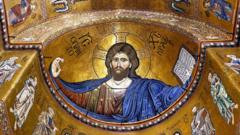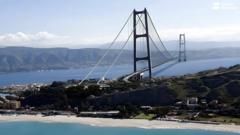The Monreale cathedral, a stunning 12th-century masterpiece perched on a hill overlooking Palermo, has been reborn following an extensive restoration. Recognized as a UNESCO World Heritage Site in 2015, it is renowned for having Italy's largest collection of Byzantine-style mosaics, second only to those in the Hagia Sophia.
The elaborate mosaics, intended to captivate and inspire visitors with their grandeur, span an impressive 6,400 square meters and are adorned with approximately 2.2 kilograms of gold – a symbol of the divine in Byzantine art. The restoration project, led by the Italian Ministry of Culture, has involved meticulous cleaning and repairing of the tiles, which had suffered from decades of neglect.
Father Nicola Gaglio, who has served as a priest at Monreale for 17 years, describes the challenges faced during restoration. The team had to approach the work cautiously, addressing unexpected complications, such as removing a yellowed layer of varnish from the ceiling.
In addition to restoring the mosaics, the cathedral has also been equipped with a modern lighting system. Matteo Cundari, the Country Manager of Zumtobel, emphasizes that the old system was energy inefficient and inadequate in showcasing the beauty of the artwork. The new lighting has been designed to be energy-efficient and completely reversible, ensuring that future updates can be made without further damage to the historic site.
This initial restoration phase, costing around 1.1 million euros, has already brought forth plans for a subsequent project focused on revitalizing the central nave. Father Gaglio expresses profound admiration upon witnessing the scaffolding removed and the mosaics radiating anew. He reflects on the cathedral's importance, stating, "This world needs beauty, because it reminds us of what's good in humanity, of what it means to be men and women."
The elaborate mosaics, intended to captivate and inspire visitors with their grandeur, span an impressive 6,400 square meters and are adorned with approximately 2.2 kilograms of gold – a symbol of the divine in Byzantine art. The restoration project, led by the Italian Ministry of Culture, has involved meticulous cleaning and repairing of the tiles, which had suffered from decades of neglect.
Father Nicola Gaglio, who has served as a priest at Monreale for 17 years, describes the challenges faced during restoration. The team had to approach the work cautiously, addressing unexpected complications, such as removing a yellowed layer of varnish from the ceiling.
In addition to restoring the mosaics, the cathedral has also been equipped with a modern lighting system. Matteo Cundari, the Country Manager of Zumtobel, emphasizes that the old system was energy inefficient and inadequate in showcasing the beauty of the artwork. The new lighting has been designed to be energy-efficient and completely reversible, ensuring that future updates can be made without further damage to the historic site.
This initial restoration phase, costing around 1.1 million euros, has already brought forth plans for a subsequent project focused on revitalizing the central nave. Father Gaglio expresses profound admiration upon witnessing the scaffolding removed and the mosaics radiating anew. He reflects on the cathedral's importance, stating, "This world needs beauty, because it reminds us of what's good in humanity, of what it means to be men and women."

















